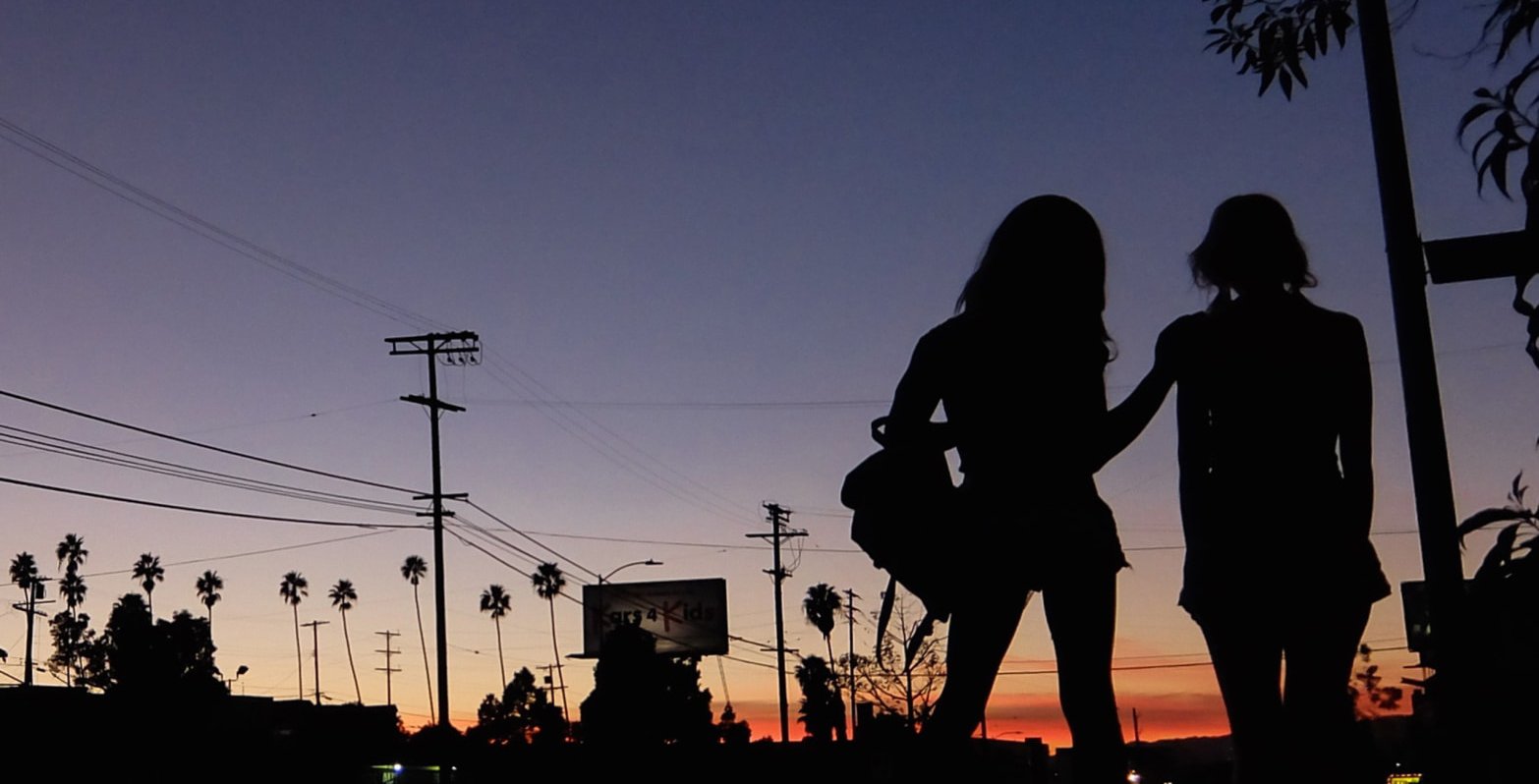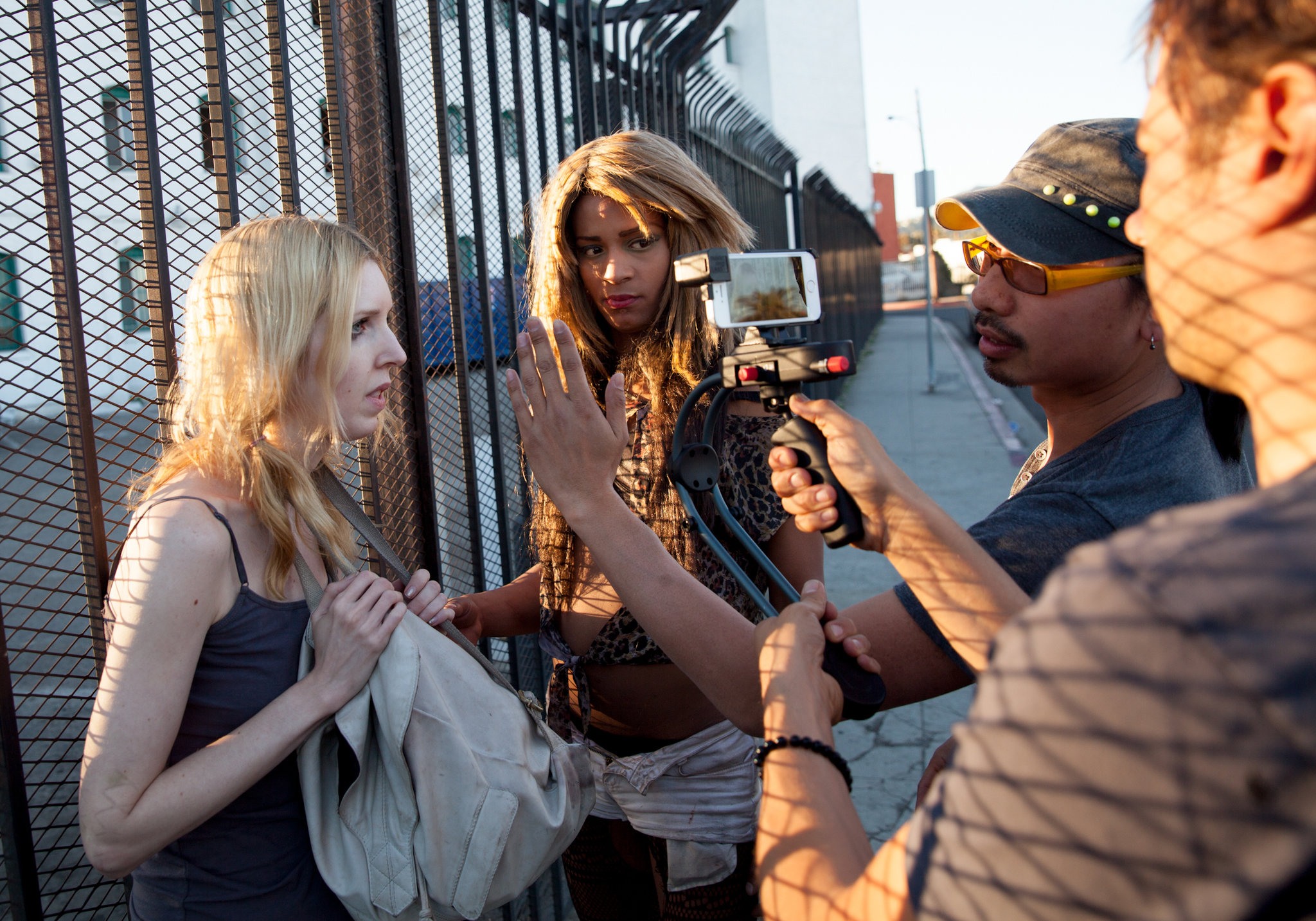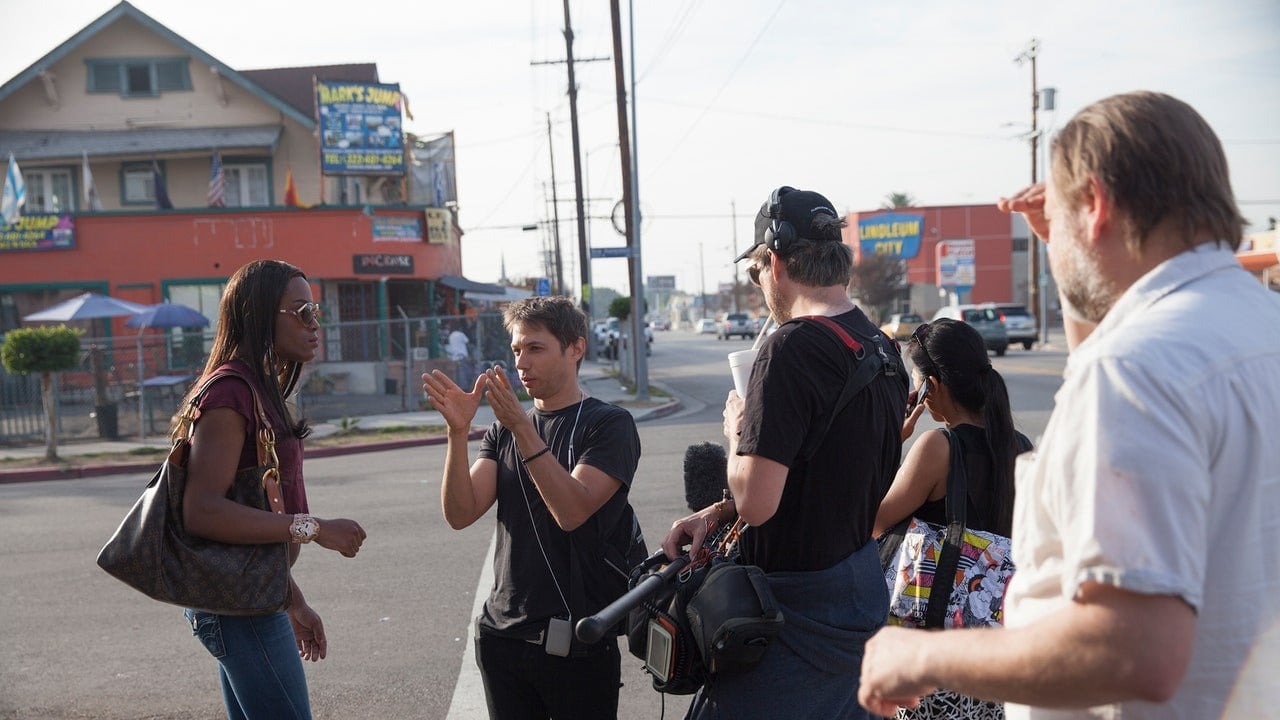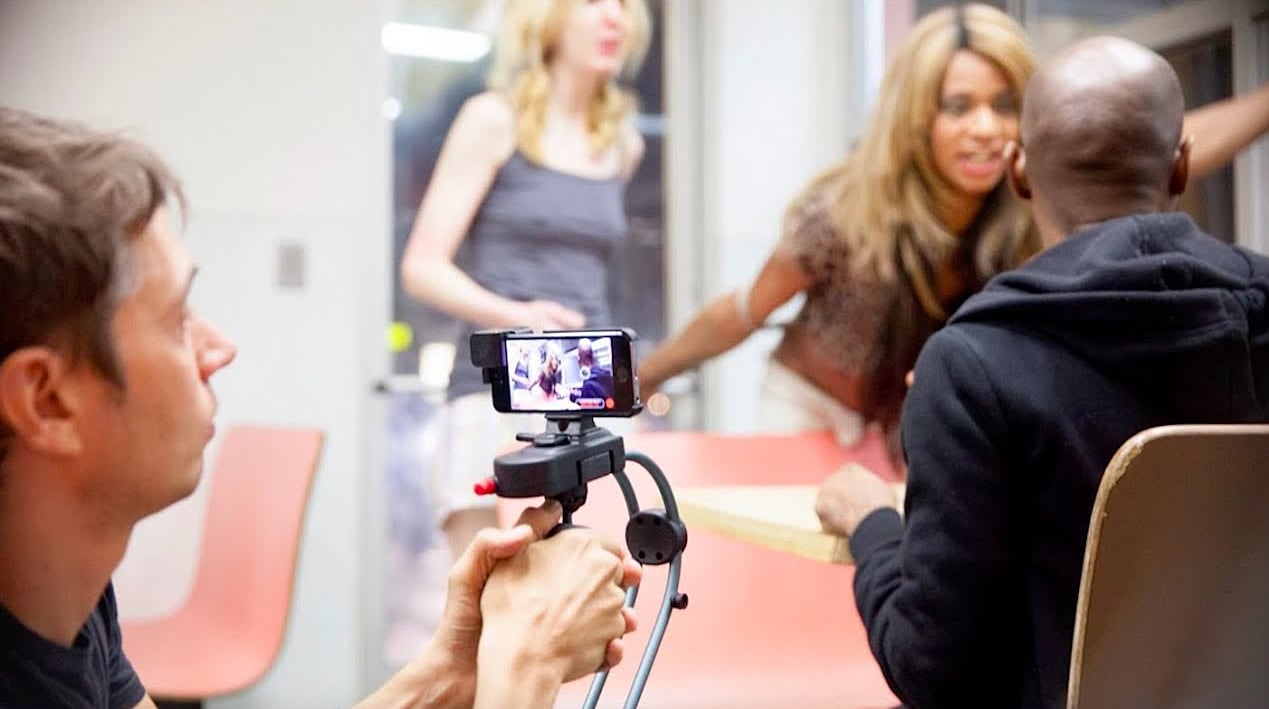
Tangerine: iPhone Enables Streetwise Story
Shot largely in natural light, the look of this edgy indie drama was enhanced with anamorphic adapter and an imaging app.
This article originally appeared in AC February, 2015. Some photos are additional or alternate.
After the world premiere of Tangerine at Sundance, a collective gasp rose from the audience when director/writer/editor Sean Baker revealed that the widescreen movie had been shot entirely on three iPhone 5Ss. “We decided, let’s go for something very different with the look,” said the L.A.-based hyphenate, who also shared cinematography credit with his longtime collaborator, Radium Cheung, HKSC. The festival was soon buzzing about the project's technical novelty, as well as its humor and heart.

At its essence, Tangerine is a story of two transgender girlfriends who work the streets of L.A. It’s the day before Christmas, and Sin-Dee Rella (Kitana Kiki Rodriguez) has just returned from a month in jail. When her friend Alexandra (Mya Taylor) lets slip that Sin-Dee’s pimp-boyfriend, Chester (James Ransone), has been sleeping with “a fish” (a biological female), she dials up the histrionics and vows to track them down for a confrontation. The prostitutes scour the neighborhood, Sin-Dee on the hunt and Alexandra handing out flyers promoting her singing engagement that night. Meanwhile, in a seemingly unrelated plotline, the film follows an Armenian cab driver, Razmik (Karren Karagulian), as he picks up motley fares throughout the day. It turns out this married father is very much on a first-name basis with these working girls. The two stories converge in a screwball blowout at Donut Time, Chester’s unofficial office.
Baker and co-writer Chris Bergoch developed the story in close collaboration with Taylor and Rodriguez, who served as their conduit to the world of transgender prostitution around the Hollywood intersection of Santa Monica Boulevard and Highland Avenue. (The film was largely cast from this pool of pros.) In a Q&A at the Sundance premiere, Taylor recalled mentioning two stipulations: The film should be “brutally real,” showing what these girls endure on a daily basis, and it should be funny, “because I want to be entertained, and the girls want to be entertained, and this should be a movie for them as well.”

Baker knew this would be a no-budget production, as films about transgender characters tend to be a hard sell to financiers. (Even Apple politely told them, “We wish you luck,” according to the producer.) What’s more, this was Baker’s fifth feature, “so I couldn’t be calling in favors anymore,” says the director, whose previous features include Prince of Broadway, Take Out and Starlet. Baker says he appreciates the look of today’s DSLRs, “but we wanted to separate ourselves from the pack.”
When Baker told Cheung that the budget would only permit shooting with mobile phones, “I almost hung up on him,” admits the cinematographer, who has worked with Baker for several years and made the transition from gaffer to director of photography on Baker’s 2012 effort, Starlet.
The iPhone 5S camera upgrade was an enticement, but what really convinced the filmmakers of its feasibility was a particular Kickstarter campaign. Moondog Labs, a lens developer in Rochester, N.Y., had just started fundraising for a 1.33x anamorphic adapter for the iPhone 5/5S. The $160 device clamps onto the phone and squeezes a 30-percent wider image onto the sensor, whose native video is captured in 16:9. Not only does it enable a 2.40:1 aspect ratio after a desqueeze in Final Cut Pro or Handbrake, but it also offers anamorphic touches such as horizontal flares, which Tangerine uses to great effect. “I wouldn’t have made the film without that adapter,” says Baker. “It really elevated the look.”

Moondog sent them three prototypes, each one modifying the iPhone lens to approximate a 24mm. Tangerinewas shot entirely at this focal length, giving it a distinctive look that happens to be the complete opposite of Baker’s norm. Starlet, for instance, took an observational approach and made heavy use of telephoto lenses. Tangerine’s wide-angle close-ups are in your face — which is completely in line with the high-voltage characters. “Aesthetically, it worked to enhance the way we were covering our subjects, which was almost a happy accident and something I’m very grateful for,” says Baker. “It brings the audience closer to these characters. Empathy is the most important thing, allowing the audience to experience this stuff with them. That’s why we went with this style, to immerse you in the hardship and chaos of the area.”
Two other tools made the iPhone feasible: the app Filmic Pro and a Steadicam Smoothee.
Using the third iteration of Filmic Pro, the filmmakers could manually lock in focus, color temperature, exposure and more. “Once you lock those, you roll and shoot,” says Cheung. “You can’t pull focus; you can’t change exposure.” On the downside, not being able to push in from a wide to a close-up meant all close-ups had to be staged as separate shots. But the few times they chose not to lock focus and exposure, they regretted it. “You can actually see some of the jumps as the camera looks for its focal point,” Baker says.
Another reason Filmic Pro was employed in virtually every shot was its enhancement of the phone’s compression rate. Offering 50mbps encoding at 1080p, the app’s compression made on-set media management a breeze. “I think we only filled up the phone one time because the files are so small,” says Baker. The raw files were downloaded from the phone via iTunes to a MacBook Pro every evening after the shoot. When the footage was later converted from H.264 to ProRes 4:2:2, “that increased the size of every file significantly," he notes.
Steadicam’s Smoothee, a handheld gimbal rig with an iPhone 5/5S mount, was “imperative,” says Baker. “You cannot hold an iPhone totally still. No matter how stable you are, your hand cannot do it. Because it’s such a small lens, you see every little movement and feel [every] breath.” Cheung concurs, “It would have looked like home video.” As with any stabilizing rig, the trick was getting enough practice. While Baker had two months of prep time, Cheung was tied up on the FX series The Americans and had only Christmas vacation to get used to the rig. He spent that week in Germany chasing after his toddler-aged goddaughter with it, which proved to be an ideal crash course.
For his part, Baker conquered the Smoothee well enough to use it one-handed while riding a bike. An avid cyclist and former bike messenger, Baker turned his 10-speed into a nimble two-wheeled dolly, doing 360s around his characters or zipping past them with the energy of a skateboarder.
It was during prep that Baker discovered another key component of the movie's look: its amped-up color. Again, this was a 180-degree turn. “The sort of films I make have this urban social-realist thing,” Baker says. “What I normally do is drain the color because for some reason, that adds to the reality.” But after trying that with test footage in Final Cut Pro, he pondered other options. “Because these women are so colorful, I decided to try going the other way, and I tried pumping up the saturation instead. Almost immediately, I was sold. One movie critic called it ‘pop vérité,’ and that was exactly the combination I was looking for.”
That palette is evident from the very first shot: a close-up of a canary-yellow tabletop in Donut Time. Color influenced many location choices. “Sean was very insistent on being geographically correct,” says Cheung. “For instance, if they’re supposed to be walking from east to west, we honored that. But during that stretch, we were quite flexible about whether we’d shoot on this block or the next.” They staged scenes next to huge graffiti murals, strings of Christmas lights, colorful sidewalk benches, bus seats covered with wild print fabrics, and a bathroom with red walls and blue disco light. The colors were saturated in the final grade, which was done on DaVinci Resolve at Different by Design in L.A. “[Colorist] Luke Cahill did a wonderful job,” says Baker. “He ended up using more Power Windows to highlight faces and make it look more cinematic and professional overall. It should be noted that we added grain to the entire picture. Again, giving it a filmic look was important to me.”
For the 22-day shoot, Cheung brought only three battery-operated Rosco LitePads — 1’x1’, 6”x12” and 3”x12” — “just to be able to fill in and add some eyelight every now and then,” he says. Bounce material picked up at a 99-Cents Only Store was used occasionally. “We had no C-stands, no conventional movie lights,” says Cheung. “We staged our actors with existing light on locations, to some degree, and I turned those existing lights on and off selectively.”
The largest setup was Alexandra’s performance at the club, but there, too, Cheung worked with existing units. “They were what you’d find in a comedy club,” he says. “I just changed and refocused the Par bulbs and put a little gel on them.
“From the beginning, we embraced the realistic elements of this picture,” Cheung continues. “Sometimes we had to just let it go, like if the actors went dark now and then. There were some scenes where I wished I had a Kino [Flo], but we decided early on that was not something we were going to do.”
One of the great advantages of a minimal camera and lighting package was that passers-by barely gave them a glance. “Nobody realized we were filming or took it seriously,” says Cheung. “After the first two days, we realized this approach really had a benefit!” Although the production obtained permits for all locations, they didn’t have anyone to lock down streets, so life on Santa Monica and Highland cruised through the shots. In this sense, the mobile phones added considerably to the filmmakers' goal of realism. “Trying to make it an entertaining film and a social-realist film was a balancing act that went all the way through production and post,” says Baker. “We found the style slowly.”
Cheung would go on to shoot episodes of such series as The Blacklist, Billions, The Sinner and Hightown.
Baker would go on to write and direct The Florida Project, shot by Alexis Zabe, ASC.
The iconic Donut Time bakery would later become Trejo's Coffee & Donuts.






